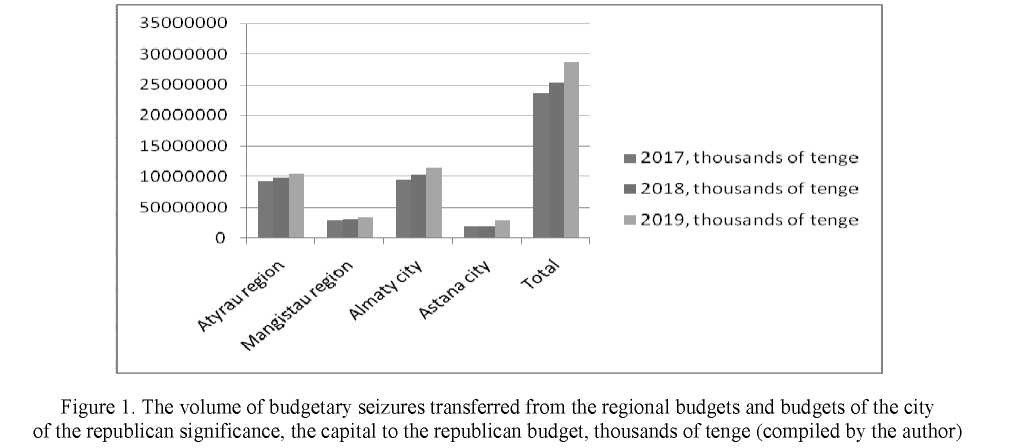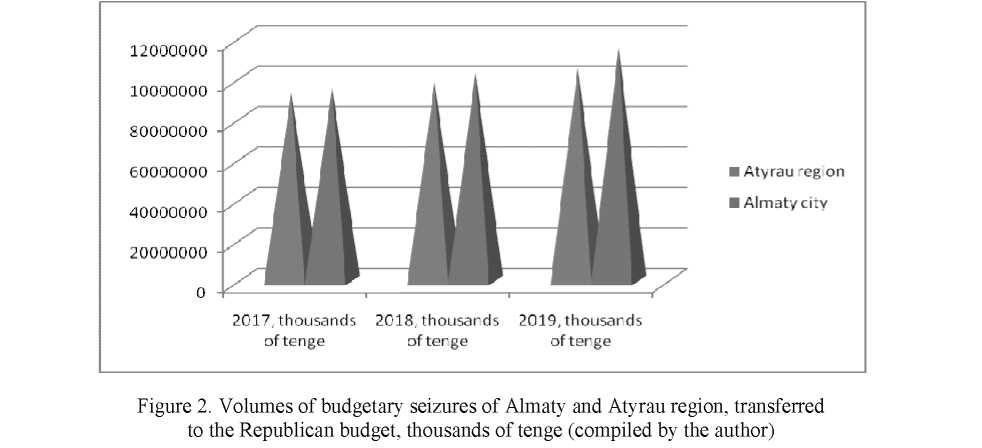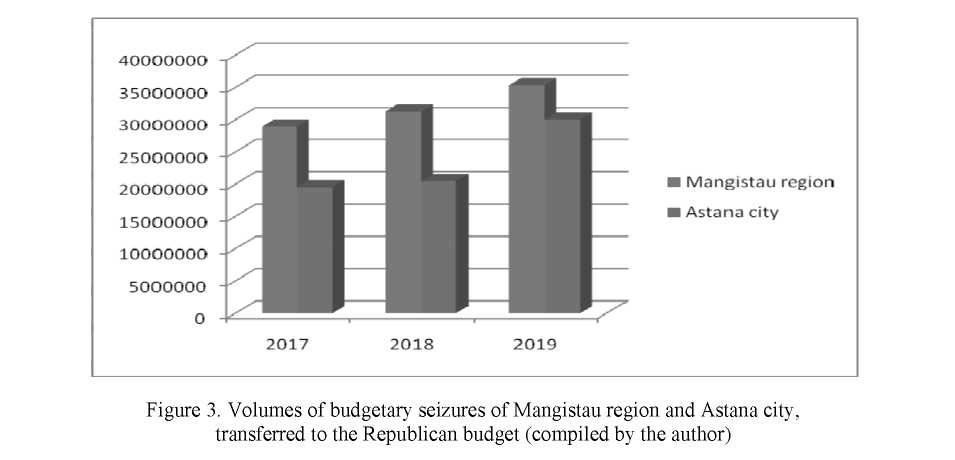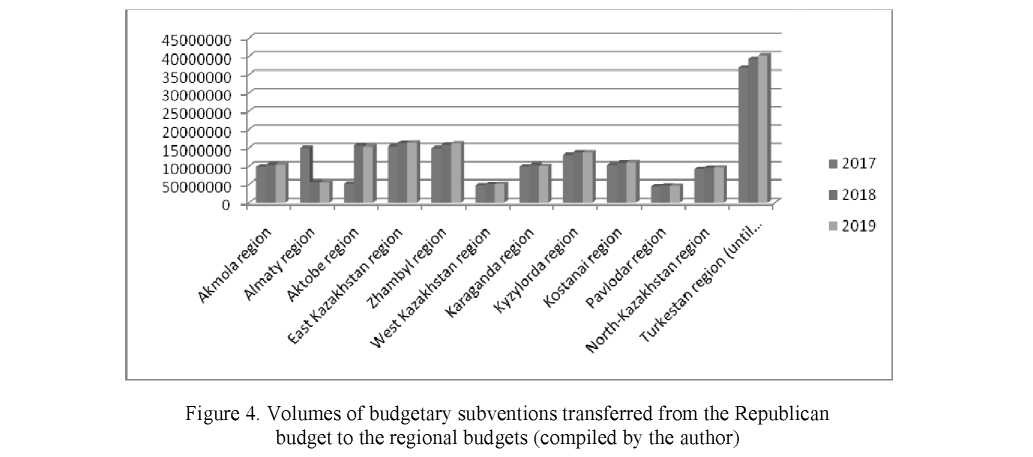In the article the author investigated the budgetary imbalance, the reason of which is in the existing distortions concerning withdrawal in the republican budget from donor regions and the subsequent subventions for regions recipients. The definition is given to the budgetary equalization and also the reasons which have an impact on the existing imbalance are stated. The comparative analysis of volumes of the budgetary withdrawals is carried out to the republican budget of four donor regions. Also the author carried out the analysis of the transferred volume of the budgetary subventions from the republican budget to regions recipients. The volumes of withdrawals and subventions are presented by years in the form of diagrams. In the article state programs of development of regions are mentioned, actions on prevention of the existing budgetary imbalance between regions are defined. In the research a conclusion is presented that nowadays the disproportion in formation of revenues of local budgets of certain regions is observed that serves as loading for the republican budget which in turn withdraws considerable financial resources from some regions and transfers to others. This problem is caused by regional differences in the plan of socio-economic development which such factors as population density, problems of uneven placement of productive forces and the fixed business assets, current state of the social sphere and also the level of development of a business sector on regions.
As it is known, significant territorial differences, which are largely determined by such features as: economic, natural and climatic, resource, and infrastructural, contribute to significant differences in the level of budgetary security of the population of single regions. A high degree of dependence includes the population with the necessary set of public goods and services which directly depend on the level of sufficiency of budgetary funds and give rise to the need of equalization of regional differences in budgetary security, which subsequently causes the state to use budget adjustment tools in budget policy.
Budget equalization is a process that is carried out by the state authorities of a higher level in order to prevent differences in the levels of social and economic development of the state's territories, ensuring the balance of budgets of all levels and equal opportunity to implement social guarantees on the whole territory I1].
Budget equalization is carried out through a number of mechanisms defined by the budget policy of the state and single territories.
As in many countries, the Republic of Kazakhstan has regions with sufficient tax potential, they are called «donor regions», as well as less developed regions, which are called «recipient regions» Of course, unfortunately, nothing is perfect, and there have always been and will be «rich» and «poor» regions. In the context of inter-budgetary relations, the burden of equalizing regional development in the country is largely superimposed on donor regions, but it is necessary to take into account the number of donor regions and recipient regions I2].
There are 14 regions in the Republic of Kazakhstan, and as of 2018 there are 3 cities of republican significance, only 17 regions (up to 2018 16 regions, Shymkent has acquired the status of a city of republican significance). From the above, it should be noted the fact, that only 4 regions in the country are donor regions, while the others are dependent on them. It should be borne in mind that the number of donor regions has changed in 2015. The city of Astana was added to their number, which in 2014 the city was a recipient region. It should be noted that this is a big disproportion. It implies that there are 3 recipient regions per donor region or as they are called subvention regions I3].
It is known that the budget of the Republic of Kazakhstan is considered, approved and implemented for a period of three years. According to the Law of the Republic of Kazakhstan «On the volume of general transfers between the republican and regional budgets, budgets of the city of republican significance, the capital for 2017–2019», the value of budgetary seizures transferred from the regional budgets and budgets of the city of the republican significance, the capital in the republican budget by years are presented in Table 1.
Table 1
The volume of budget seizures transferred from the regional budgets and budgets of the city of Republican significance, the capital to the Republican budget (thousands of tenge)
|
Region |
2017 |
2018 |
2019 |
|
Atyrau |
93073240 |
98079854 |
105177356 |
|
Mangistau |
28977170 |
31316423 |
35365489 |
|
Almaty |
95217756 |
102907355 |
115389732 |
|
Astana |
19539853 |
20467618 |
30039508 |
|
Total |
236808019 |
252771250 |
285972085 |
Note. Compiled by the author according to sources [3, 4].
From the presented table, it follows that, from year to year budgetary seizures from the donor regions to the republican budget increase both in the aggregate volume and in the context of the regions. So, the total amount of seizures in 2017 was 236808019 thousand tenge; in 2018, the amount of seizures is 252771250 thousand tenge, which is 15963231 thousand tenge more than in 2017; for 2019 the total amount of seizures of donor regions is 285972085 thousand tenge, which is 33200835 thousand tenge more than 2018 and by 49164066 thousand tenge more than 2017, respectively (Fig.1).
It is clear, from the presented table and figure 1 that the leader among the donor regions from year to year is the city of Almaty, almost on an equal footing is Atyrau region being in second place, the third position is occupied by Mangystau region, and Astana is the fourth leader.
The total amount of budgetary seizures by years shows that the budgetary withdrawals of 2019 are provided in the amount of 285972085 thousand tenge, which is 33200835 thousand tenge more than in 2018 and is 11.6 %, in 2018 total withdrawals amounted to 252771250 thousand tenge and more 6.3 % of 2017, is 15963231 thousand tenge.
From the presented information it is necessary to carry out the comparative analysis between regions on the amounts of seizures to the Republican budget. So the undoubted leader by years is the city of Almaty, in the second place is Atyrau region. A comparative analysis between these two donor regions is presented in Figure 2.

From the comparative analysis of the presented regions it follows that the difference between Almaty and Atyrau region is 2144516 thousand tenge or 2.25 % in 2017. In 2018, the volume of seizures of Almaty is more by 4827501 thousand tenge, which is 4.6 %, in 2019, the withdrawals from the budget of Almaty city will amount to 115389732, which is 8.8 % more in Atyrau region and is 10212376 thousand tenge.
Having made a comparison between the donor regions that are leaders in this category, a comparison should also be made between the regions closing this position, particularly, Astana and Mangystau region (Fig. 3).
A comparative analysis between these two donor regions shows that Mangistau Region is undoubtedly the leader towards the city of Astana. This can be explained by the fact that Astana has recently become a donor region, and this is explained by the existence of factors that are mentioned at the beginning of the article. In a breakdown by years, the following picture is observed. So, in 2017 Mangistau region ahead of Astana on the amount of budgetary seizures to the Republican budget for 9437317 thousand tenge, which is 32.5 %. Despite the fact that in 2018 the amount of seizures in the budget of the city of Astana increased, but the gap from Mangistau region increased by 2.1 % and amounted to 34.6 % against 32.5 % in 2017. This situation is explained by the fact that in Mangistau region the amount of seizures also increased and amounted to 31316423 thousand. tenge against 20467618 thousand tenge of the city of Astana. In 2019, the amount of seizures will be 35365489 thousand tenge in Mangistau region, and 30039508 thousand tenge from the budget of the city of Astana. The difference between the regions is 5325981 thousand tenge or about 15 %. A marked decline compared to previous years.


Having considered the donor regions and the total value of seizures from their budgets to the Republican budget, it is necessary to analyze the situation in the remaining subventional regions, which is presented in Table 2.
Table 2 The volume of budget subventions transferred from the Republican budget to the regional budgets (thousands of tenge)
Note. Compiled by the author according to sources [3, 4].
|
Region |
2017 |
2018 |
2019 |
|
Akmola |
98876923 |
104043009 |
104474017 |
|
Almaty |
149323221 |
56275267 |
55812434 |
|
Aktobe |
52075219 |
156003745 |
153723098 |
|
East Kazakhstan |
154177713 |
163157610 |
163954224 |
|
Zhambyl |
148950489 |
158021243 |
161934587 |
|
West Kazakhstan |
47523970 |
50857832 |
51393369 |
|
Karaganda |
98979375 |
103899796 |
100730628 |
|
Kyzylorda |
130493866 |
137143159 |
137165718 |
|
Kostanay |
103540487 |
108989956 |
110192744 |
|
Pavlodar |
43979033 |
46829053 |
46106965 |
|
North-Kazakhstan |
91616267 |
95748762 |
96360248 |
|
Turkestan (until 19.06. 2018. YUKO) |
368753673 |
392376072 |
402300571 |
|
Total |
1488290236 |
1573345504 |
1584148603 |
The information in Table 2 shows that budget subventions in the country are growing from year to year, however it can be seen that in some regions the amounts vary from year to year. Figure 4 shows these differences.
According to the given information of the diagram presented in Picture 4, there is a conclusion that can be represented by the rating of regions taking into account 5 places. So, undoubtedly, the first place in the volume of subventions is occupied by the Turkestan region (the former South Kazakhstan), the second place in the rating is taken by Aktyubinsk, East Kazakhstan and Zhambyl region, we note that in 2017, it was possible to include Almaty region. In the third place according to the diagram is the Kyzylorda region. Almost equal in subventions from year to year are Akmola, Karaganda, Kostanay and North Kazakhstan regions. The five recipient regions of Almaty, West Kazakhstan and Pavlodar regions are closing, and in 2017 Aktobe region was on an equal footing with them.

According to the regional analysis, the conclusion is that there is a significant difference between the individual regions in obtaining subventions. However, if we compare the aggregate amounts of subventions of all regions, except for Turkestan region, we see that in 2017 the region received 32.9 % of the subventions from the total allocated and the Republican budget. In 2018, the region allocated 33.2 % of the total amount of subventions, and in 2019 the volume will amount to 34.03 % of the total volume from the Republican budget.
Therefore, according to the article, it follows that nowadays there is a disproportion in the formation of the revenues of the local budgets of individual regions, which serves as a burden for the Republican budget, which in turn seizes significant financial resources from donor regions, which are the «minority» in our country. The regional difference of socio-economic development is influenced by such factors as population density, and in the south it is the highest, the uneven distribution of productive forces and production assets, the condition of the social sphere, the development of the business sector, and so on.
The state fully contributes to the equalization of the level of social and economic development of the territories. This should be judged, because today there are state programs. For example, the program «Serpin — 2050» «Mangilik el zhastary — industriya», the purpose of which is to train and employ young people from the southern region of the country (Almaty, Turkestan, Zhambyl, Kyzylorda, Mangistau regions) with an excess of labour resources in the east, north and west of Kazakhstan — in regions experiencing a shortage of personnel.
A unified program of business support and business development «Business Road Map 2020» promotes the growth of business structures in the regions, creating a favorable investment and tax climate. The program for the development of regions until 2020, goal of which is to create conditions for the development of socio-economic potential of the regions through the formation of a rational territorial organization of the country, stimulating the concentration of population and capital in the centers of economic growth.
In the Strategy «Kazakhstan 2050»: the new political course of the matured state, also paid special attention to budgetary policy. Within the framework of the budget policy, the head of state focuses on the fact that the budget process should be built on new principles, which involves spending on opportunities, reducing the budget deficit to a minimum, building up reserves and saving for the next generation. It is necessary to consider and execute the budgetary process in the context of preventing a budget imbalance, which is generated by the difference in the amounts of budgetary exemptions and subventions I5].
Therefore, increasing the tax potential in regions, through the development and support of business structures, the rational allocation of productive forces, a favorable investment and tax climate, will increase the revenues of local budgets of the recipient regions, which will reduce the burden on the donor regions. It should be noted that the aforesaid activities in the country have been developed and adopted for implementation in various programs and normative legal acts, but they are not fully implemented in the regions. At the same time, local executive authorities need to actively participate in the implementation of the state strategy, guided by the principles of transparency, openness, prevention of corruption schemes and lobbying of interests, as well as the patronage of certain interested groups, thereby reducing the imbalance of regional development, while donor regions to maintain their positions, and to regions-recipients to become competitive regions, to join the number of regions-leaders.
References
- Biudzhetnyi kodeks Respubliki Kazakhstan ot 4 dekabria 2008 h. No. 95-IV [The Budget Code of the Republic of Kazakhstan (December 4, 2008). № 95-iv]. zakon.kz. Retrieved from https://www.zakon.kz [in Russian].
- Aigazin, Zh.Zh. Bohatye rehiony Kazakhstana bohateiut, a bednye — bedneiut [The rich regions of Kazakhstan are getting richer while poor regions are getting poorer]. forbes.kz. Retrieved from https://forbes.kz [in Russian].
- Ofitsialnye dannye Ministerstva Natsionalnoi ekonomiki RK. Komitet po statistike [Regulation of the Ministry of National Economy of the Republic of Kazakhstan. The Committee on Statistics]. stat.gov.kz. Retrieved from http://stat.gov.kz [in Russian].
- Zakon Respubliki Kazakhstan ot 29 noiabria 2016 hoda No. 24-VI «Ob obieemakh transfertov obshcheho kharaktera mezhdu respublikanskim i oblastnymi biudzhetami, biudzhetami horoda respublikanskoho znacheniia, stolitsy na 2017–2019 hody» [The Law of the Republic of Kazakhstan of November 29, 2016 No. 24-vi «On the amount of general transfers between the republican and regional budgets, budgets of the city of Republican significance, the capital for 2017–2019»]. (2016, 29 November). online.zakon.kz. Retrieved from http://online.zakon.kz [in Russian].
- Ofitsialnyi sait Prezidenta RK [Official website of the President of the Republic of Kazakhstan]. akorda.kz. Retrieved from http://www.akorda.kz [in Russian].